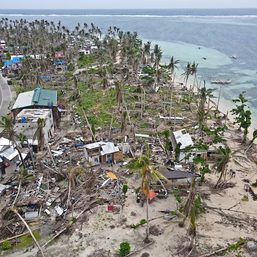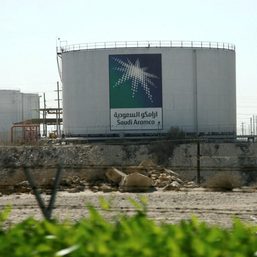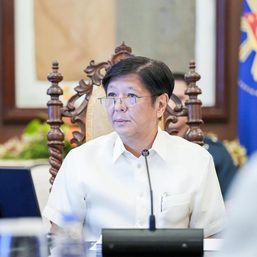SUMMARY
This is AI generated summarization, which may have errors. For context, always refer to the full article.
![[OPINION] Grading Marcos admin’s performance on the climate agenda](https://www.rappler.com/tachyon/2024/06/grading-marcos-performance-climate-agenda-june-25-2025.jpg)
At the start of his term, President Ferdinand Marcos Jr. mentioned the climate crisis as a focus agenda of his administration. Within the next two years, its impacts have never been more directly experienced by Filipinos across the country in different forms.
The most notable example of these is the recent El Niño, coupled with rising temperatures. Not only did it adversely affect the agricultural and water sectors, but it also normalized the trend of class suspensions due to extreme heat, a stark contrast to the usual basis of heavy rainfall or storms hitting communities.
While the climate crisis as an issue remains not as well-understood in daily discourse, its effects on the economy, society, and environment are becoming more noticeable to policymakers, experts, and observers.
From the energy and mining sectors to human rights and environmental justice, it is vital for the Philippine government to set the right direction on addressing arguably the biggest threat to the country’s pursuit of sustainable development.
The question now is this: Has the Marcos Jr. administration done enough to enable effective climate action in the Philippines?
Is there progress?
In recognition of the evolving climate-related challenges and needs, different branches and agencies of the government are developing new bills and plans to address them.
At the legislative branch, lawmakers have proposed legislation that responds to the needs of different sectors. One of the most contested bills is the low carbon economy bill, which would establish a carbon pricing framework and system as part of setting an economy-wide pathway for the country to reduce its greenhouse gas (GHG) emissions. While still at the committee level, business and civil society groups are debating on the necessity and operationalization of this system.
Another bill known as the climate accountability bill would strengthen business accountability for potential pollutive actions. It would also establish a national loss and damage (L&D) fund to support victims of climate-related catastrophes, a fitting proposal as the country recently commemorated the 10th anniversary of the onslaught of Super Typhoon Yolanda (Haiyan).
The government also recently published its National Adaptation Plan, which presents the strategy to reduce climate vulnerabilities and protect communities and ecosystems from worsening impacts. Covering sectors such as agriculture, health, biodiversity, human settlements, and cultural heritage, it also defines outcomes and activities for the country to achieve its national development targets while enhancing resilience.
Still on the pipeline are the country’s NDC (Nationally Determined Contribution) Implementation Plan, which would define how it would reduce its GHG emissions by 75% within the current decade, and its updated Philippine Energy Plan that ideally would hasten the development of cleaner technologies and reduce emissions coming from energy, the nation’s most climate-pollutive sector.
The government is also strengthening its partnerships with various sectors to further enable climate solutions. The coverage of these collaborations ranges from protecting blue carbon to enabling the attainment of net-zero emissions, although they need to be backed by comprehensive policies and plans that have yet to be developed or finalized.
Where is the connection?
As good as these new policies and plans are, a deeper examination reveals that there remain several levels of disconnect within the Philippines’ climate governance system that would prevent their intended outcomes from being fully achieved.
First, there is the incoherence of the supposed climate policies being championed by the current leadership. This is most evident in Marcos’ preferred energy options: a combination of renewable energy (RE), nuclear, and fossil gas to replace coal as the dominant parts of the country’s energy mix. While this is geared toward securing national energy supply, this policy direction is inherently contradictory, such that it would likely prevent the simultaneous attainment of climate, energy, and development targets.
Second is the inconsistency between the government’s global positions and its local actions. For example, the Philippines is currently part of the L&D Fund Board and is openly bidding to be its host. While this is aligned with the country’s call for climate justice for the most vulnerable, there is no domestic L&D policy with a strong climate lens, with current policies more oriented on addressing losses and damages from disasters.
Third is the discrepancy of the “whole-of-society” approach to climate governance among national agencies. Initiatives by the likes of the Climate Change Commission, Department of Agriculture, and National Disaster Risk Reduction and Management Council for involving nongovernment groups in decision-making are noteworthy. However, issues on the lack of transparency by some agencies, including during consultations at the national and local levels, and gaps in coordination about mandates related to climate action threaten to undermine these good practices on inclusion.
Fourth is the poor protection of human rights, especially in marginalized communities. For instance, in the context of just energy transition, communities affected by mining for minerals needed to produce solar panels and storage batteries continue to experience harassment, abuse, and the pollution, if not destruction, of nearby ecosystems on which they depend. The disregard of the Commission of Human Rights by some of the higher-ups is another indicator of this issue that persists in the Philippines, one of the world’s most dangerous countries for environmental defenders.
What is the grade?
Any policy or plan is only as good as its implementation. As long as the usual problems of corruption, red tape, lack of transparency, exclusion of non-business, nongovernment stakeholders, and outright power-tripping persist within the Philippine government, climate action will be reduced to words of unfulfilled potential and lip service.
We have seen this with how, despite the enactment of the RE Act 16 years ago, the share of RE in the national energy mix actually decreased since then. We have seen this with how protected areas and ecosystems of local and cultural significance that contribute to adaptation and mitigation continue to get polluted or destroyed.
So far, the Marcos Jr. administration has actually fared better than its predecessor on advancing the climate agenda in the Philippines. But not by much. And on an absolute scale, until we see results, not good enough. – Rappler.com
This article is part of “Marcos Year 2: External Threats, Internal Risks,” a series of analyses and in-depth stories assessing the second full year of the Marcos administration (July 1, 2023, to June 30, 2024).
John Leo is the national coordinator of Aksyon Klima Pilipinas and the deputy executive director for Programs and Campaigns of Living Laudato Si’ Philippines. He has been representing Philippine civil society in United Nations climate and environmental conferences since 2016. He has been a climate and environment journalist since 2016.
Add a comment
How does this make you feel?

![[OPINION] No room for ‘business as usual’ in era of climate emergency](https://www.rappler.com/tachyon/2024/06/no-room-business-as-usual-climate-change-june-25-2024.jpg?resize=257%2C257&crop_strategy=attention)



![[In This Economy] Why we need to stop the proposed Laguna de Bay expressway](https://www.rappler.com/tachyon/2024/06/Why-we-need-to-stop-Laguna-de-bay-expressway-June-28-2024.jpg?resize=257%2C257&crop=458px%2C0px%2C720px%2C720px)

![[Rappler’s Best] Fasten seatbelt, Mr. President](https://www.rappler.com/tachyon/2024/07/fasten-seatbelt-mr-president-edit.jpg?resize=257%2C257&crop=235px%2C0px%2C720px%2C720px)

![[OPINION] Power of mimicry: How human rights are covertly undermined in PH](https://www.rappler.com/tachyon/2024/06/duterte-marcos-human-rights.jpg?resize=257%2C257&crop_strategy=attention)
![[Vantage Point] BBM Year 2: Hits and misses](https://www.rappler.com/tachyon/2024/06/thought-leaders-marcos-hits-and-misses.jpg?resize=257%2C257&crop=277px%2C0px%2C720px%2C720px)

![[OPINION] Climate finance: A call to action for the Philippines](https://www.rappler.com/tachyon/2024/05/tl-climate-finance.jpg?resize=257%2C257&crop=458px%2C0px%2C1080px%2C1080px)





There are no comments yet. Add your comment to start the conversation.